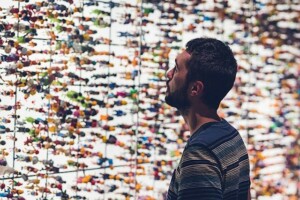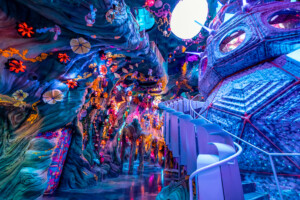The International Aquarium Congress (IAC) takes place every four years and is a prestigious and vitally important event within the public aquarium industry worldwide. Cape Town's Two Oceans Aquarium won the bid to host the event in September 2012 and it will be the first time that the Congress is on the African continent and in the southern hemisphere.
Dr. Patrick Garratt (below), Managing Director of The Two Oceans Aquarium has an outstanding academic background, has published over 50 scientific  papers, survived two disasters at sea (once spending 22 hours in the water) and was instrumental in setting up and ensuring the success of one of South Africa’s leading tourist attractions, The Two Oceans Aquarium. With the 2012 IAC just a few months away, Charles Read caught up with him.
papers, survived two disasters at sea (once spending 22 hours in the water) and was instrumental in setting up and ensuring the success of one of South Africa’s leading tourist attractions, The Two Oceans Aquarium. With the 2012 IAC just a few months away, Charles Read caught up with him.
Related: 8th International Aquarium Congress: Internationally Renowned Scientists to Speak / Interview with Ted A. Beattie, CEO, Shedd Aquarium / Interview with Dr Dave Gibson, MD, National Marine Aquarium / Chicago’s Shedd Aquarium welcomed Over 2.1 million guests in 2011
The International Aquarium Congress (IAC) 2012
The 2008 Congress in Shanghai was a great success. What are your expectations for this year’s event?
We are expecting between 400 – 500 delegates from about forty countries to attend.
The IAC is an opportunity to showcase Cape Town and the Western Cape. How closely are you working with local tourist organisations?
We have had a close working relationship with the Cape Town Convention Bureau which is responsible for marketing the Western Cape as a business tourism destination. Further, the MEC for Finance, Economic Development and Tourism, Alan Winde is one of three officials invited to give presentations at the IAC opening ceremony. We are also working closely with several tourist attractions including Marine Dynamics, Strandloper Safaris, Cape Eco-Tours and Apex Shark Expeditions so that delegates have the opportunity to experience some of the incredible natural beauty surrounding Cape Town.
The opportunity to even bid to host the IAC only comes around once every 12 years. What were the key components of The Two Oceans bid which helped ensure its success?
There were several: The Two Oceans Aquarium’s international reputation for excellence was without doubt key, but our bid document was also very strong and professional and showed quite clearly that we have the ability to hold such a conference. Further to this, we are grouped with Europe and the Middle East in the bidding process and, as the Europeans have hosted the IAC on several occasions in the past, it was felt that it was time to take it into the southern Hemisphere. Then Africa itself, with its extraordinary beauty, its incredibly rich biodiversity, its interesting history and diverse cultures was also a contributing factor.
What unique benefits will the Cape Town location bring to the IAC?
Cape Town is regarded as one of the most beautiful cities in the world. It is also the melting pot of cultures – a meeting place of diverse peoples for hundreds of years. It’s fitting that we expose the global aquarium community to this wonderful place. Also, the city sits close to the site where  two of the world’s mightiest oceans meet in a style not seen anywhere else in the world and to a hinterland that is mind-blowing in terms of its beauty and diversity.
two of the world’s mightiest oceans meet in a style not seen anywhere else in the world and to a hinterland that is mind-blowing in terms of its beauty and diversity.
Please tell us about “Voices for the Future of the Oceans”.
Conservation efforts and decisions taken now will affect the children of tomorrow. “Voices for the Future of the Oceans” is a way of involving youth from around the globe in the IAC and giving them the opportunity to voice their concerns about their future and the future of the oceans. The process involves linking up young people associated with aquariums around the globe through live video conferencing, so that they can share their views on ocean issues and have their voices heard during the congress.
The Two Oceans Aquarium will host IAC 2012. What will the aquarium itself bring to the event?
In terms of the Aquarium, delegates will be exposed to exhibits almost entirely from this region and, therefore, quite unique. They will also be exposed to a facility that achieves a lot with very little. In my view we are a great aquarium yet we have one of the lowest cost and smallest footprints in the world. As a stand-alone facility with no support from municipal or regional governments, we are a financially viable institution that puts a lot of money and energy into education, conservation and research. In a world of decreasing support for these facilities, I believe that we have a lot to offer in terms of our business model and modus operandi.
operandi.
In terms of the Congress, we have introduced a number of things that will make this IAC quite different to those that have gone before. Possibly the most important one being the encouragement and facilitation of discussion and debate.
Two Oceans Aquarium and one of the most biologically diverse regions of the world.
What can you tell us about current initiatives or developments at the aquarium?
the aquarium?
Currently, the Aquarium is running extremely well. It is financially stable, its exhibits have never looked better and its drive to educate the children of South Africa is gaining momentum year on year. In our view, education is our raison d’être. We are also steadily improving in our sustainability efforts and reducing our impact on the environment.
Nonetheless, we have also been very active in the fields of conservation and research. For several years we have been releasing our big Ragged-tooth sharks back into the wild, equipped with satellite tags and ultrasonic tags. I think that we were the first aquarium to do this. This project has produced some amazing results and they will be presented at the Congress by our Curator, Michael Farquhar. In recent years there has been a major thrust by our marine scientists to deploy large numbers of ultra-sonic ‘base stations’ along our coasts and accordingly, we will be equipping future tagged sharks with ultrasonic tags.
Recently, we have concentrated our research efforts in the field of parasitology. We have partnered with the Monterey Bay Aquarium to investigate the optimal use of the drug “praziquantel” in the treatment of monogenean parasites (responsible for disease and host mortality) of captive fishes. The results of this work could be hugely beneficial to public aquariums and aquaculture facilities in the future.
What has given you most satisfaction in seeing the aquarium develop over the last 17 years?
I would have to split my answer into two parts. In the eight years in which I was Curator, my greatest satisfaction came firstly from the freedom to continually change exhibits and secondly from the care, attention to detail and high maintenance standards kept by our staff.
In the eight years in which I have been Director, it would undoubtedly be being part of a remarkable management team that took the business and the heart of the organization to another level. It has been remarkable to watch the team’s growth and to witness the development of one of the most cohesive units I have ever seen.
 What is unique about the oceanic environment around the Cape and how is this reflected in the exhibits?
What is unique about the oceanic environment around the Cape and how is this reflected in the exhibits?
With two completely different ocean regimes to the east and west of us, one warm and one cold, and a 1000km south coast with a high degree of endemism sandwiched between them, we have one of the most biologically diverse regions of the world at our doorstep. As a result, we have access to a huge variety of animals and plants – all of which are collected by our staff. You will note that we have very few “international visitors”.
As far as we have been able, we have separated out the warm and cold water animals and plants into different galleries, but our larger displays tend to hold a good mix of both, a reflection of the great 1000km ‘mixing zone’ on our south coast.
Any notable breeding successes?
From an aquarium perspective, we have had great success in breeding the Knysna Seahorse. In fact, we have had to manipulate water temperatures so that they do not over-run the Aquarium! In terms of aquaculture, we helped commercial companies pioneer the culture of Kob (Drum) and Yellowtail using eggs naturally spawned in our displays. Today, the culture of Kob, in particular, is a rapidly growing industry in South Africa.
What can you tell us about new exhibits (permanent and temporary) or developments? 
You will often hear members of our staff stating that “we change with the tides”. Each year we undertake a number of changes in order to keep the aquarium fresh and interesting. Taking a long view, we have a Development Plan that includes: a new Predator Display, a dedicated Big Shark Display, an Antarctic/Southern Ocean Island Display, a substantial Children’s Centre, an extension of the fresh water River Meander and what we commonly refer to as an “Antarctic Gateway”, which will showcase the work our scientists are doing in the southern oceans.
You recently held an evening of “songs, sounds and poetry” (i.e. the 16th June). What are significant revenue streams: corporate , live events, conferences etc?
Significant alternative revenue streams include our Shoreline Cafe, the Aquarium Shop, Evening Functions, Conferences, Membership, Sport Diving and Birthday Parties. The evening of Songs, Sounds and Poetry is just one example of an evening function.
The Aquarium has been well received, how do you plan to keep the experience fresh and exciting for the guest in the next 5, 10, 20 years?
Introducing the various phases of our Development plan over a number of years should take care of this. Also, once this plan is complete, we will hav e reached a ‘critical mass’ that will allow us to undertake major changes without having to add further to the building.
e reached a ‘critical mass’ that will allow us to undertake major changes without having to add further to the building.
To what degree is social media having an impact on the engagement you have with the aquarium’s visitors? Any notable new initiatives?
Technology is moving fast in every facet of life and at times it is hard to keep up. The Aquarium is connected to social media (Facebook, Twitter, etc), but the next technological initiative will be to develop apps specifically for the aquarium industry.
Challenges facing public aquariums
Which other aquariums do you admire and why?
Each of us has our favourites. Top of my list is Monterey Bay Aquarium because they do everything so well and their exhibits are magnificent. But, of the ones I have visited I would include, amongst many others: Tennessee, Baltimore, Vancouver, Lisbon, Ocean Park (Hong Kong), Shanghai, Tokyo Sea Life Park, Nagoya and Toba. I should qualify my response, however, by stating that each aquarium has its gems in terms of exhibits and its specialities in terms of conservation and education. I am often asked what the best aquariums in the world are and I refuse to comment as it’s impossible to make comparisons on that basis. I’m very happy that you phrased the question as you did.
What do you think are the key issues/challenges facing public aquaria today?
Apart from getting critical environmental messages across to our visitors, they would be to remain financially viable, to reduce our footprints and maintain our status as top visitor attractions.
Where should the fish for display marine aquaria exhibits come from? With the vast majority collected from reef environments, how can public aquaria tell the stories of marine conservation whilst relying on wild-caught specimens for display?
The animals in our aquarium are considered ambassadors for their species and for the oceans. Catching virtually all our animals on our doorstep and not mixing them with animals from elsewhere, puts us in quite an enviable position, as we have no problems with returning animals to the wild – we do this all the time. Many aquariums, however, source their animals from around the world and mix them in big community exhibits. Those animals should never be returned to the wild, as they have would have been exposed to pa rasites and pathogens from other regions which could have major impacts on ‘local’ populations. And where would they be taken anyway? Those aquariums must keep those fish until they are eaten by others (natural predation does not stop in public aquariums) or die a natural death – which doesn’t often happen in the wild or in aquariums.
rasites and pathogens from other regions which could have major impacts on ‘local’ populations. And where would they be taken anyway? Those aquariums must keep those fish until they are eaten by others (natural predation does not stop in public aquariums) or die a natural death – which doesn’t often happen in the wild or in aquariums.
The second part of your question opens the door to an interesting debate and in this respect I ask the question: While humanity continues to remove millions of tons of fish and other animals and plants from the oceans on a daily basis, for food and even for fertilizer, how can anyone point a finger at public aquariums who are taking orders of magnitude less and keeping them alive to increase awareness and concern for the future of those same animals and oceans?
There is growing evidence that people are suffering from "environmental despair" regarding the state of the planet. The Monterey Bay Aquarium recently created a positive and hopeful exhibit about climate change. Whilst it is incumbent upon museums and aquariums to educate, how is this best done?
Edmund Burke’s quote: “Nobody made a greater mistake than he who did nothing because he could only do a little.” is relevant to the environmental despair we are seeing all around us. To get out of the mess that we are in, every person can and must make behavioural changes. Collectively we can change the world without sinking into the abyss of despair. This is the message that aquariums need to convey to our visitors and the public at large.
I salute the Monterey Bay Aquarium for the conceptualization and fabrication of this innovative display and I urge aquariums worldwide to find the “keys of hope” in their communities. In my view, it’s the only way forward. Dr Kelsey’s keynote presentation at the IAC on “hope” promises to be an eye-opener in this regard. (See also: US Survey Shows Zoo and Aquarium Visitors More Concerned About Climate Change.)
With the various challenges facing the marine and aquatic environment, from coral bleaching to climate change and pollution, what work and developments give you cause for optimism?
We are seeing many changes in attitude within the leaders of industry and business world-wide. An example would be Irvin and Johnson, a leading fishing company in our region, which has discontinued sea-bed trawling and instituted new long-line fishing methods to prevent/reduce the mortality of seabirds.
On a global scale, there is also the knowledge that there are millions of people working towards a better future – not just a few of us!
Much more than either of these, however, is the groundswell of determination and optimism I am seeing amongst the younger generations . It is astounding!
. It is astounding!
Making an unforgettable and memorable experience.
Who has inspired you and why?
On this one I could write a book! To name a few: my uncle, Sam Tingle, who was a Formula 1 racing driver and competed with world champions such as Jack Brabham, Graham Hill, Stirling Moss and Jackie Stewart. He showed me that anything was possible if you put your mind to it. Then there was Jacques-Yves Cousteau who convinced me, through his films and life style, to become a Marine Biologist. Prof. Anne Alexander of Natal University taught me so much about life and stretched me to the limit in terms of the requirements of academia. Prof Lev Fishelson of Tel Aviv University, a man of boundless energy and enthusiasm, became my mentor during the most exciting part of my research and kept me in the field of Marine Biology in desperate financial times. Lex Fearnhead, the founding Director of the Two Oceans Aquarium, who taught me most of what I needed to know as a Curator and later put me on the path to becoming the Director of the Aquarium.
Are there any particular aspects or sessions of IAC 2012 you are particularly looking forward to?
Our intention is to make every session an unforgettable and memorable experience, so it’s difficult to single out any one aspect. However, having said that, including the youth in the IAC, and introducing delegates to the magic of Cafe Conversations are two aspects that come to mind!
Delegates will be given the opportunity to go great white shark cage diving or whale watching, which would you recommend?
Both, but I urge delegates not miss the chance to dive with Great White Sharks – it’s an experience of a lifetime! As is a visit to Africa.
Images (From the top):
1. Youth looking into the future – Photo kind courtesy Two Oceans Aquarium. 2. Dr. Pat Garratt– Photo: G. Spiby. 3. The Two Oceans Aquarium entrance shot – Photo: H. Lockhart. 4. Kelp-F-01 – Photo: S. Lennert. 5. Cape Point – Photo kind courtesy Cape Town Tourism. 6. Greenpoint stadium – Photo kind courtesy Cape Town Tourism. 6. Photo: G. Spiby. Maxine, the first Aquarium ragged tooth shark to be tagged with a satellite tag and released back into the ocean after nine years on display. 8 & 9. Whale breaching and Great White Shark kind courtesy Marine Dynamics.











